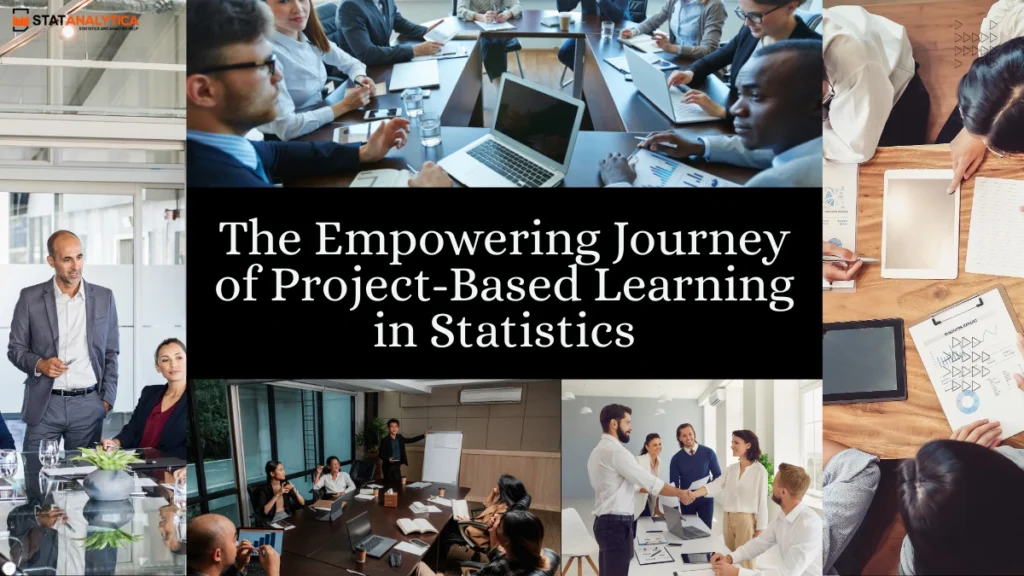Are you ready to move beyond tedious textbooks and embrace a truly exhilarating approach to understanding data? Prepare to be utterly transformed! Project-based learning in statistics isn’t just a buzzword; it’s a revolutionary methodology that empowers students, sparks genuine curiosity, and fosters an incredibly deep, practical mastery of statistical concepts. Imagine a learning environment where every challenge is an opportunity, every dataset tells a story, and your analytical skills blossom with real-world application. This isn’t a dream; it’s the vibrant reality of project-based statistics.
The days are gone when statistics felt like an abstract, intimidating subject. With project-based learning (PBL), statistics becomes a dynamic, living discipline. It’s about getting your hands dirty with real data, tackling authentic problems, and discovering the profound impact of statistical thinking in our everyday lives. From deciphering local economic trends to analyzing global health data, PBL makes learning statistics an unforgettable and immensely rewarding journey.
Project-Based Learning in Statistics
Table of Contents
Why Project-Based Learning is the Future of Statistics Education
The traditional “lecture and test” model often leaves students feeling disengaged and wondering about the practical relevance of what they’re learning. Project-based learning (PBL) flips this script entirely. It plunges learners into authentic, complex problems where they must discover and apply statistical principles to find solutions. This active, inquiry-driven approach is not only more engaging but also profoundly effective in developing critical thinking, problem-solving abilities, and a robust understanding of statistical methodology.
Consider this: In a traditional classroom, you might memorize a formula for hypothesis testing. In a PBL setting, you’d design an experiment, collect data, choose the appropriate hypothesis test based on your data type, run the analysis, and then interpret the results to answer a real question – perhaps whether a new teaching method at a local school genuinely improves student performance. Which experience do you think will lead to deeper learning and lasting retention? The answer is brilliantly clear: PBL.
Igniting Curiosity: The Core Pillars of Project-Based Learning in Statistics
At its heart, project-based learning in statistics thrives on several key principles that make it exceptionally powerful:
- Authenticity: Projects are based on real-world problems or scenarios, making the learning immediately relevant and meaningful. This could involve analyzing voter turnout data, evaluating the effectiveness of a marketing campaign, or even exploring climate change patterns.
- Student-Centered Approach: Learners are not passive recipients of information but active participants who drive their own learning process. They often choose topics, design methodologies, and lead the inquiry.
- Inquiry-Driven: Questions, not answers, are at the forefront. Students are encouraged to ask “why,” “how,” and “what if,” fostering a genuine spirit of investigation.
- Collaboration: Working in teams is common, mirroring real-world professional environments where data analysis is often a collaborative effort. This builds essential communication and teamwork skills.
- Interdisciplinary Connections: Statistics rarely exist in a vacuum. PBL projects often naturally integrate concepts from other subjects like economics, biology, sociology, or environmental science, highlighting the versatile nature of statistical thinking.
- Emphasis on Process and Product: While a final deliverable is important, the journey of data collection, analysis, interpretation, and refinement is equally, if not more, valuable.
- Reflection and Revision: Continuous feedback, self-assessment, and opportunities to refine one’s work are integral, promoting metacognition and improvement.
Key Benefits: Why Every Statistics Learner Deserves This Experience
The advantages of embracing project-based learning in statistics are truly abundant and transformative:
- Deeper Conceptual Understanding: Moving beyond rote memorization, students genuinely grasp why certain statistical methods are used and what their results truly mean.
- Enhanced Problem-Solving Skills: Learners develop the ability to break down complex problems, identify relevant data, apply appropriate tools, and draw evidence-based conclusions.
- Boosted Critical Thinking: Students learn to question assumptions, evaluate sources, interpret results with nuance, and understand the limitations of data.
- Real-World Data Proficiency: Direct experience with messy, imperfect real-world datasets prepares students for challenges outside the classroom.
- Improved Communication Skills: Presenting findings, explaining methodologies, and collaborating with peers are vital components of PBL.
- Increased Engagement and Motivation: Tackling interesting, relevant problems makes learning exciting and fosters a genuine passion for statistics.
- Development of Data Literacy: In today’s data-driven world, the ability to understand, analyze, and interpret information is paramount. PBL directly cultivates this essential skill.
- Career Readiness: These are the exact skills that employers are desperately seeking in fields ranging from data science to market research, public health, and engineering.
Designing an Impactful Project-Based Learning Experience in Statistics
Crafting effective statistics projects requires thoughtful design. Here’s a blueprint for creating truly empowering and educational experiences:
1. Identify a Compelling Real-World Problem or Question (The Hook!)
Start with an engaging scenario. What local issues in the USA could be explored? What global challenges resonate with students?
- Example: “Is there a statistically significant difference in air quality metrics (e.g., PM2.5 levels) between urban and rural areas in a specific U.S. state, such as California, during different seasons?”
- Example: “Does the number of hours spent on social media correlate with academic performance among college students?”
Example: “Evaluate the effectiveness of a local public health campaign in reducing the incidence of a specific disease.”
2. Define Clear Statistical Learning Objectives
What specific statistical concepts and skills should students master through this project?
- Examples: Data collection methods, descriptive statistics, inferential statistics (e.g., t-tests, ANOVA, chi-square), correlation, regression, data visualization, hypothesis testing.
3. Provide Access to Relevant Datasets (or Guide Data Collection)
Real data is key! This could be:
- Publicly available datasets: Government statistics (e.g., from the U.S. Census Bureau, CDC, or EPA), international organizational data, and scientific repositories.
- Simulated datasets: Carefully designed to mimic real-world complexity if real data is too sensitive or hard to obtain.
4. Structure the Project with Clear Milestones
Break the project into manageable phases to guide students and allow for regular feedback.
- Phase 1: Problem Definition & Research:
- Formulate a research question.
- Identify potential data sources.
- Review relevant literature.
- Deliverable: Project proposal.
- Phase 2: Data Collection & Preparation:
- Gather data (or access provided datasets).
- Clean and organize data.
- Address missing values, outliers.
- Deliverable: Cleaned dataset and data dictionary.
- Phase 3: Exploratory Data Analysis (EDA) & Visualization:
- Calculate descriptive statistics (mean, median, mode, standard deviation).
- Create various charts and graphs (histograms, box plots, scatter plots, bar charts).
- Identify patterns, trends, and anomalies.
- Deliverable: EDA report with visualizations.
- Phase 4: Inferential Statistics & Modeling:
- Choose and apply appropriate statistical tests or models based on the research question and data type.
- Perform hypothesis testing.
- Deliverable: Statistical analysis report with software output (e.g., R, Python, SPSS, Excel).
- Phase 5: Interpretation & Communication of Findings:
- Interpret statistical results in the context of the original problem.
- Draw conclusions and make recommendations.
- Communicate findings effectively through presentations, written reports, or interactive dashboards.
- Deliverable: Final report and presentation.
Table: Recommended Statistical Tools for PBL
| Tool/Software | Key Features | Best For | Learning Curve |
| R | Advanced analysis, research, and data science. | Versatile programming language, excellent for data manipulation, analysis, and machine learning. | Moderate to High |
| Python (with libraries like Pandas, NumPy, SciPy, Matplotlib, Seaborn) | Basic analysis, data organization, and introductory courses. | Data science, scripting, web integration. | Moderate to High |
| Jupyter Notebooks | Social sciences, quick analysis, and beginners. | Explanatory analysis, sharing workflows for project-based learning in statistics. | Low to Moderate |
| SPSS | User-friendly, menu-driven statistical software. | An interactive computing environment combines code, output, and markdown text. | Low |
| Excel (with Data Analysis ToolPak) | Widely available, basic statistical functions, pivot tables, charts. | Collaborative projects, surveys, and quick data sharing. | Low |
| Google Sheets | Cloud-based, collaborative, basic functions. | Collaborative projects, surveys, quick data sharing. | Very Low |
| Tableau/Power BI | Data visualization and business intelligence tools. | Presenting findings, creating interactive dashboards. | Low to Moderate |
5. Foster Collaboration and Provide Support
Encourage group work and provide ample opportunities for students to consult with instructors and peers. Offer resources like statistical software tutorials, data cleaning guides, and examples of past projects.
6. Emphasize Communication and Presentation
Learning statistics is incomplete without the ability to clearly articulate findings. Dedicate time for students to practice presenting their methodologies, results, and conclusions. This is where their data storytelling skills truly shine.
Transforming Classrooms: Real-World Examples of Project-Based Learning in Statistics
Let’s look at some inspiring scenarios where project-based learning in statistics comes alive:
Example 1: Local Environmental Impact Assessment (USA Focus)
- Problem: Does the recent increase in industrial activity around a specific American town, such as in a manufacturing hub in Pennsylvania, have a measurable impact on local river water quality (e.g., levels of dissolved oxygen, pH, pollutants)?
- Project: Student teams collect water samples from various points along a local river over several weeks, testing for key indicators. They then use descriptive statistics to summarize their findings, apply inferential tests (like t-tests or ANOVA) to compare different locations or time periods, and visualize their results using charts.
- Learning Outcomes: Data collection ethics, sampling techniques, descriptive statistics, hypothesis testing, data visualization, environmental statistics, and local civic engagement.
- Impact: Students become citizen scientists, contribute to local knowledge, and understand the role of statistics in environmental policy.
Example 2: Analyzing Consumer Preferences for a Local Business
- Problem: A new café opening in a bustling neighborhood in New York City wants to understand local coffee preferences (e.g., preferred bean type, sweetness level, price sensitivity) to optimize its menu.
- Project: Student teams design and administer surveys to local residents. They then use techniques like frequency distributions, cross-tabulations, and chi-square tests to identify relationships between demographic factors and preferences. They might also explore correlation between price and willingness to purchase.
- Learning Outcomes: Survey design, sampling bias, categorical data analysis, descriptive statistics, basic inferential statistics, market research, business analytics.
- Impact: Students provide actionable insights to a real business, gaining practical experience in market research.
Example 3: Health Data Trends and Public Awareness Campaign Evaluation
- Problem: A local health clinic in a U.S. state wants to assess if its recent public awareness campaign about flu shot efficacy has led to a reduction in reported cases.
- Project: Teams access anonymized public health data (before and after the campaign). They use time-series analysis or compare pre/post-campaign incidence rates using appropriate statistical tests. They might also analyze factors like age, location, or socioeconomic status to identify at-risk groups.
- Learning Outcomes: Time-series data analysis, comparative statistics, public health data interpretation, epidemiological basics, ethical data handling.
- Impact: Students contribute to understanding public health effectiveness and learn how statistics informs health policy.
Overcoming Challenges in Implementing Project-Based Learning in Statistics
While immensely beneficial, implementing PBL in statistics can present some hurdles. However, with foresight and strategy, these can be effectively navigated:
- Time Commitment: Projects require significant time for design, execution, and feedback.
- Solution: Integrate projects across a semester, break them into smaller, manageable chunks, and provide clear timelines.
- Resource Availability: Access to relevant data, software, and computational tools.
- Solution: Utilize free online datasets, open-source software (R, Python, Google Sheets), and leverage university computer labs or cloud-based solutions.
- Student Preparedness: Some students may lack initial skills in data handling or programming.
- Solution: Scaffold learning with mini-lessons on essential tools, provide templates, and encourage peer mentorship. Start with simpler projects and gradually increase complexity.
- Assessment: How to fairly grade a complex, multi-stage project.
- Solution: Use rubrics that assess various components (proposal, data cleaning, analysis, interpretation, presentation, collaboration). Assess both process and final product.
- Ethical Considerations: Especially when dealing with real-world data involving people.
- Solution: Emphasize data privacy, anonymization, informed consent (if collecting data), and responsible data interpretation from the outset.
The Enduring Value: Fostering Lifelong Learners and Data-Savvy Citizens
Project-based learning in statistics is more than just a teaching method; it’s a philosophy that believes in the power of doing, discovering, and creating. It empowers students to become confident, capable, and curious individuals who aren’t just consumers of information, but skilled producers and critical evaluators of data.
In an increasingly data-saturated world, the ability to think statistically is no longer a niche skill – it’s a fundamental literacy. By embracing the vibrant, hands-on approach of project-based learning, we are not just teaching statistics; we are cultivating the next generation of problem-solvers, innovators, and informed citizens.
Also Read: Incredible and Inspiring Real-Life Applications of Inferential Statistics
How is PBL different from a traditional statistics class?
In a traditional class, you might listen to lectures, read a textbook, and complete problem sets and tests. The focus is often on rote memorization of formulas and procedures. In contrast, PBL in statistics centers on a real-world project. You’ll learn the necessary statistical concepts as you need them to solve the problem, making the learning more practical and meaningful. The focus is on application, critical thinking, and communication rather than just recall.
Do I need to be an expert in programming to do a PBL statistics project?
No, you don’t. While tools like R and Python are powerful for advanced analysis, many projects can be completed using more accessible software. Excel and Google Sheets have built-in functions for basic statistical analysis and visualization. The key is to choose the right tool for the project’s complexity and your skill level. The focus is on the statistical thinking process, not just the technical tool.
Can I do a PBL project on my own, or is it always a group activity?
PBL can be done individually, but it’s often a collaborative group activity. Working in a team mirrors how data analysis is done in the professional world and helps build essential teamwork and communication skills. Collaboration allows for the sharing of ideas, division of labor, and peer support, making the learning process richer and more efficient.


